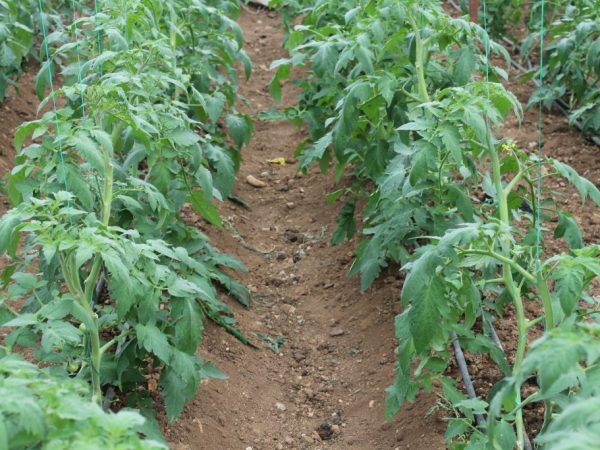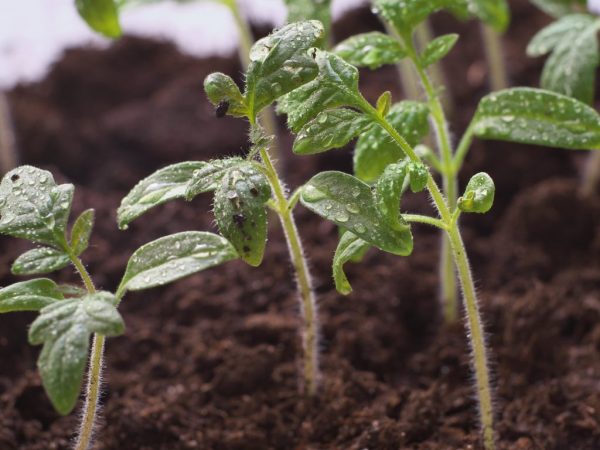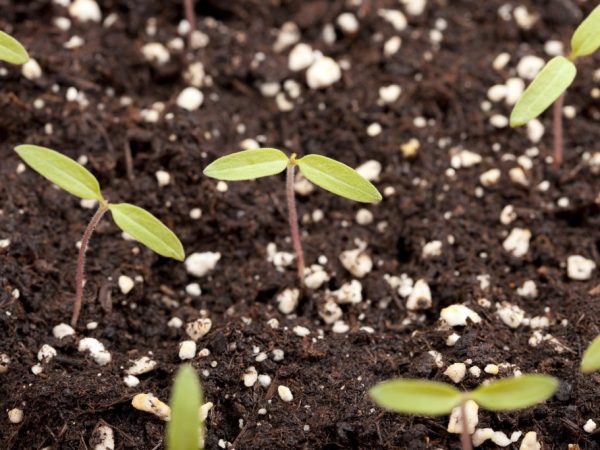How to choose soil for tomatoes
Tomato is one of the most common crops. The successful cultivation of a vegetable depends on the quality of the soil in which it grows. Soil for tomatoes is characterized by many characteristics. Each of them affects the taste, appearance and yield of the crop. Let's analyze what kind of soil tomatoes love.

Soil for tomatoes
Soil acidity
The ideal soil for tomatoes is drained, loose, rich in organic matter. The plant likes neutral or slightly acidic soil, but not acidic. The acidity should be within ph7. If this norm is not followed, then the seeds may not germinate. Check the soil like this:
- use a ready-made test or ordinary litmus paper;
- take a little soil and spill 9% vinegar, with abundant foaming - the soil is alkaline, with moderate foaming - neutral, no foam - acidic.
If the soil is acidic, then liming. Lime can be added both in autumn and spring. Lime should not be slaked. Add at the rate of 1-1.5 kg per 1m2, digging up a layer of earth to a depth of 20 cm.
Mineral composition of the soil
For stable growth and development, the plant needs phosphorus, potassium and nitrogen. Fertilizers based on these elements are the key to a good harvest. The plant reacts to the lack of such nutrition by its appearance:
- with a lack of nitrogen, the leaves are pale green, thin, small;
- phosphorus deficiency manifests itself in red-purple leaves, plant growth and fruit formation slows down;
- with a lack of potassium, a bronze border appears on the leaves;
- with an insufficient calcium content (oxidation), the growth point and the top of the plant die off.
Use a bacterial cocktail to improve the mineral composition of the soil. The solution contains a certain set of bacteria. They recycle the nitrogen in the soil.
Tatiana Orlova (Candidate of Agricultural Sciences):
Bacteria do not process nitrogen, but process plant residues contained in the soil, decomposing them to elementary components - nitrogen, phosphorus, potassium. There are also nitrogen-fixing bacteria that can absorb nitrogen in the air and accumulate it in the soil.
You can buy it at any gardening store. The contents of 1 ampoule are treated with 600 m2 of land.
Seedling soil
For sowing seeds, store soil, peat, black soil and substrates are used.
Shop soil
When choosing a store-bought soil, pay attention to acidity and looseness. The soil for tomatoes should be fluffy, dry, not sticky. Ready-made mixtures already contain all the necessary components, but it is advisable to treat it with a phytolavin solution, at the rate of 2 ml per 1 liter of water.
Peat
The most popular soil for tomatoes is peat. The peat content in it is about 80%. Peat is porous, air and moisture permeable. You need to add a little lime to it, 10 g per 1 kg of the mixture, to neutralize acidity.
Tatiana Orlova (Candidate of Agricultural Sciences):
It is necessary to deacidify the soil for seedlings in advance.You cannot do this immediately before sowing seeds or planting seedlings. For a chemical reaction to take place, a certain soil moisture is needed (at least 65-70%).

Grown seedlings can be transplanted into black soil
Chernozem
Black soil is also suitable for tomatoes. It contains all the necessary substances for the normal development of plants. But it is not used as a soil for seedlings. Chernozem has a high density and an excess of nutrients. Seeds are difficult to germinate. It is best used to prepare mixtures for transplanting grown seedlings.
Substrates
It is best to use seedling substrates as a soil for tomato seedlings. When self-preparing the substrate, take a light soil for tomatoes. Lightness is regulated by sand. Sand can be replaced with dry moss, coconut chips, sawdust.
Substrates are recommended to be made according to the following recipes:
- take one part of peat and coconut fiber, half a part of earth, humus, vermiculite, a little lime;
- take one part of sand, sawdust or husk, half a part of humus;
- in equal amounts vermiculite, peat and perlite;
- the same amount of soil, humus and compost, 300 g of ash, 3 tbsp. tablespoons of superphosphate, 1 tablespoon of potassium sulfate;
- mix one part of the turf turf, humus and add a little ash.
Humus can be replaced with purchased vermicompost. Peat is replaced by a mixture based on peat or sapropel - a muddy deposit of a fresh water body.
It is better to grow seedlings in a mixture of sawdust and sand in a ratio of 2 to 1. It is better to take sawdust from hardwood trees. They are sieved and impregnated with a solution of mineral fertilizers. It is advisable to use stale sawdust, otherwise, boil them with boiling water, squeeze and dry, increasing the flowability.
Tatiana Orlova (Candidate of Agricultural Sciences):
Sand for the preparation of the potting mixture is also needed of a certain type. The best is the washed coarse-grained river. Regular quarry sand - the result of marine sediments - contains salts or ferrous forms of iron. It can only be used after repeated rinsing with water.
Preparation of the mixture
Start preparing the mixture in the fall. Store the prepared soil in the cold. Frost will kill diseases and pests in the soil.
If the mixture is harvested in the spring, then use the following recommendations:
- "Fry" in the oven for an hour at a temperature of 180˚С;
- steam for 30 minutes.
Tatiana Orlova (Candidate of Agricultural Sciences):
It is undesirable to "fry" the soil, because this also kills all positive microflora. It is better to steam the soil for a short time, heating it to 60-70 degrees, carrying out, in fact, pasteurization of the soil, similar to pasteurization of milk or other products.
Site preparation
Before planting tomatoes, the ground must be prepared. The plot for tomatoes is prepared in the fall. When preparing, follow a few rules:
- take care of good illumination of the site;
- the soil should be loose and nutritious;
- the garden bed cannot be placed in the same place every year;
- do not plant in place after vegetables of the nightshade family;
- it is better to plant in the beds after pumpkin vegetables, cabbage, legumes, onions, carrots.
If in the fall they did not manage to process the site, then in the spring, before placing the tomatoes in depleted soil, process the soil with saltpeter in addition to the rest of the fertilizers. Fertilize the soil very carefully, according to the instructions.
An excess of minerals and organics harms plants more than a lack of them. They stop bearing fruit and build up the green mass.
Ground for tomatoes

The soil must be prepared
After deciding on the landing site, the earth is dug up to a depth of 20 cm, fertilizers are added. The following procedures are also carried out:
- if the earth is acidic, liming is performed;
- if clay, then add to it per 1 m2: 10 kg of coarse sand, 5 kg of peat, 5 kg of compost;
- sandy soil is enriched with chernozem, humus or compost at the rate of 10 kg per 1 m2.
These measures improve the structure of the soil.
In the spring, the site is dug up again, humus, peat, manure, and trace elements are added. Composition per 1m2: 30 g of nitroammophos, 20 g of ammonium sulfate, potassium magnesium, potassium sulfate. Then the site is dug again without turning the layer 30 cm deep.
Turf
The best soil for a tomato is meadow or forest turf. They need to stock up in advance, in summer or fall. The sod is laid out in a darkened place in layers: about 10 cm high and about 25 cm wide. The layers are laid on top of each other with grass surfaces inside. It is recommended to put humus between the layers. Such soil for tomatoes can be used as early as next year.
The following solution can be made from turf: 1 bucket of turf, 1 tablespoon of wood ash, 1 tablespoon of superphosphate, 1 tablespoon of potassium sulfate. All this is mixed and insisted for a week. The day before use, the mixture is treated with a weak solution of manganese.
Tatiana Orlova (Candidate of Agricultural Sciences):
It is more correct to say that the best soil for a tomato is not sod, but sod land. These are different concepts. Sod land, as well as compost from plant residues, is prepared for about 1.5-2 years. During this time, the plant residues in the sod are re-heated, and to speed up this process, the sod layers are mixed and watered from time to time with water.
Warm bed
Anyone who wants to harvest early can make a warm garden for the tomatoes. It has a number of advantages over conventional soil:
- the earth warms up earlier due to decaying organic matter;
- it does not need to be dug up in the spring;
- the plant is initially provided with all useful substances.
First, a trench is dug, the depth of which is 40 cm. Dense polyethylene is placed on the sides. A layer of branches and twigs, paper, cardboard, newspapers, again branches of bushes, cut grass and collected leaves from the site are laid out on the bottom. A layer of earth is poured, then a layer of manure is laid out and the soil itself on which the plant will grow, its layer should be approximately 30 cm. The bed is watered and covered with straw or agrofibre. In the spring, when the frosts come down, the bed warms up quickly. Therefore, tomatoes are planted in such soil earlier.
Conclusion
Preparing the soil for tomatoes is a difficult task. The main thing is to follow all the rules and take care of your harvest. Then all efforts will be rewarded with useful, tasty and healthy fruits.



